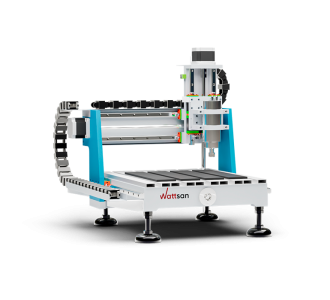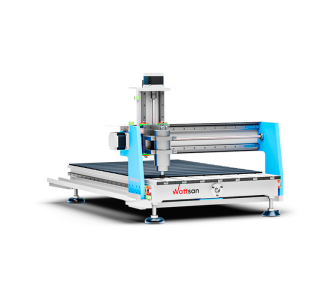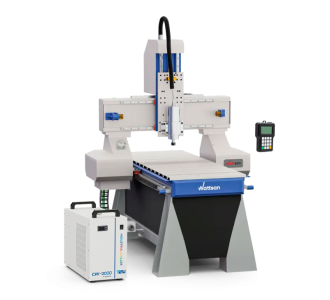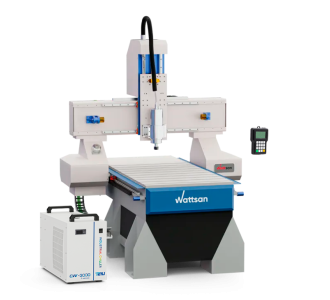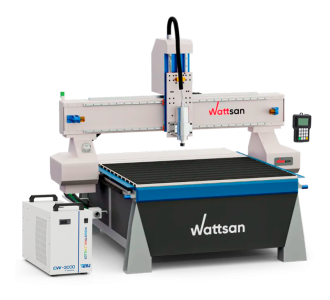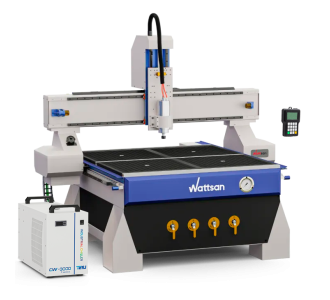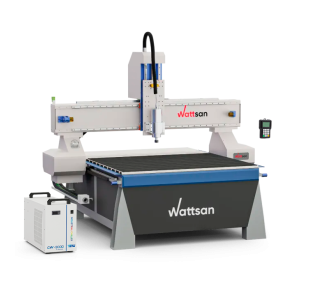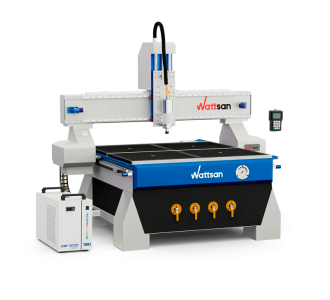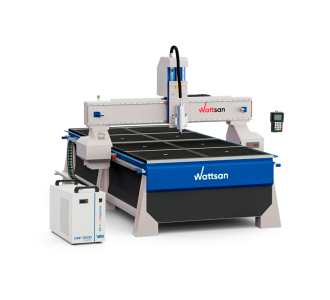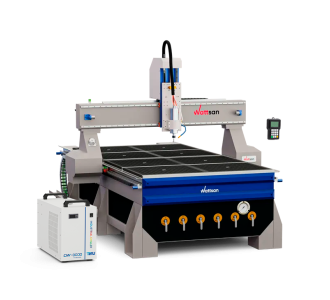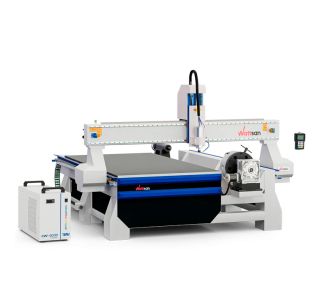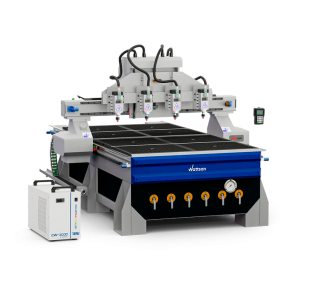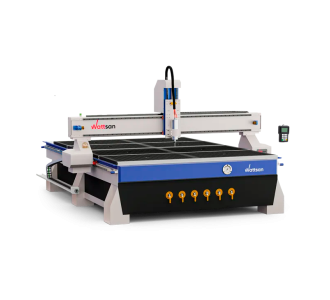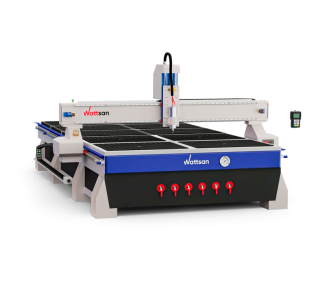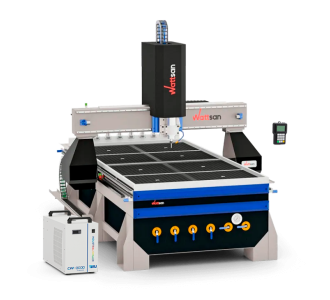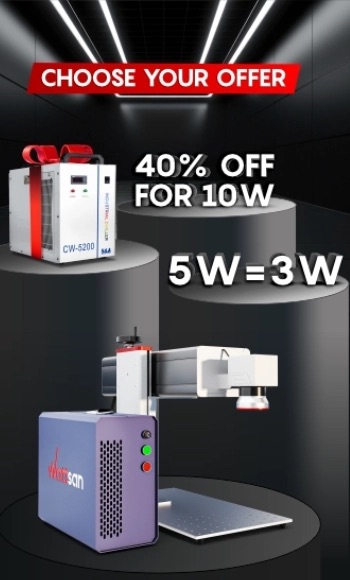We stock both table-top CNC wood routers for hobby and garage production and large-format models for any materials for large manufacturing facilities.
To find out more about CNC routers, see the catalogue or consult Virmer managers: +31208082045, info@virmer.com.
Operation principle of the CNC router machine
A numerically-controlled (CNC) milling machine is a device, all moving parts of which are controlled by a special programming language called G-code.
The main moving parts of the CNC router are:
- cutting tool,
- spindle,
- gantry.
The cutting tool, cutter or mill, is fixed in the spindle collet chuck. The spindle is attached to the CNC wood router's gantry and moves along it along the X-axis. The gantry is a special beam that moves along the Y axis along the working field, on which the material lies. The spindle moves up and down along a third axis - Z.
This enables the CNC router for wood to operate in three axes and therefore make it possible not only to cut the material on a plane, but also to perform relief machining.
The control system of the CNC wood router reads the control program and converts the G-code into pulse signals that activate the spindle and the motors responsible for the movement of the cutting tool along the axes.
The process of creating and executing a control programme has three stages:
- First, the designer or machine operator creates a 2D or 3D model of the product using CAD (Computer Assisted Design) software;
- Then converts the model drawing into machine-readable G-code using a CAM (Computer Aided Manufacturing) system and obtains a control program file where all the characteristics and movements of the cutting tool are programmed;
- Using a controller like NC Studio or an external DSP controller like RichAuto, the machine operator runs the control program and monitors the operation of the CNC router on wood or other material.
CAD and CAM systems are often implemented in the same programme, e.g. SolidWorks, Vectric Aspire, AutoCAD, ArtCAM, and others.
What can be produced with the CNC milling machine
In addition to straight and curved cutting of materials, the CNC router is also used for:
- milling, 2D and 3D machining,
- interior and exterior décor,
- relief panels, paintings, and picture frames,
- doors, casings, and window frames,
- flights of stairs,
- balusters, columns, garden sculptures, and statuettes,
- furniture, carved chairs, high chairs for children,
- tables, bar counters, coffee tables, and game tables,
- outdoor advertising, signboards, three-dimensional letters, showcases, organizers,
- cutting boards, boards for steaks and burgers, coffee coasters,
- unique handicrafts,
- industrial machine parts and auto parts,
- printed circuits,
- souvenirs, gifts, decorations, commemorative coins, branded boxes and coasters.
The CNC wood router can work not only with wood materials, but also with plastics, graphite, composite, composite epoxy material, aluminium, brass, copper, and other soft metals.
The list of possible products and applications is not limited to those listed above. The CNC router machine can be used wherever cutting and engraving, even with 3D effects, are required.
Advantages of working on CNC routers:
- Automation: simplifies, speeds up and reduces the cost of production;
- Accuracy of the CNC wood router: 0.05 mm;
- Repeatability: the products are exactly the same;
- Average useful life of CNC router is more than 10 years;
- Reduced reject rate due to numerical control;
- One machine operator can work on several CNC routers at the same time.
Criteria for choosing a CNC router machine
CNC wood router working area size
The size of the working area determines the maximum size of the product. For doors, for example, the minimum working area is 1325, i.e. 1300x2500 mm. On smaller machines, a standard door will not fit.
CNC router bed
The bed of a CNC milling machine is subject to continuous static and dynamic loads during operation so it must be rigid enough to provide the necessary level of vibration resistance.
The all-welded bed of the CNC router allows for eliminating vibrations as much as possible.
In order to eliminate distortions and deformations of the frame during the entire service life, conscientious manufacturers of CNC wood routers subject it to tempering to relieve metal stress.
CNC wood router spindle
The main characteristic of a spindle is its power. The more powerful the spindle of the CNC router, the higher its productivity.
Some models of CNC routers involve the use of several spindles at the same time to speed up working process. There are also machines with automatic tool change that use a single spindle but multiple collet chucks that change automatically.
With CNC routers, the ball and screws are responsible for the movement of the spindle in the Z-axis. Pay attention to the suitability of the ball and screw for the loads to be obtained, as well as the maximum stroke in the Z-axis; this determines the maximum material thickness and the possibility of installing a rotary device.
CNC router motors, guide rails, helical racks
Motors
Two-phase stepper motors are sufficient for the CNC router, as high speeds are not required for this type of work. It is important that the motor is fitted with a gearbox, belt or better a planetary one.
Guide Rails and helical racks
The coaxiality and parallelism of the guide rails and helical racks determines the accuracy of the machine. To ensure coaxiality and parallelism, it is important that the milling of the fitting areas for these elements is carried out by a high-precision robot after the bed has been tempered.
One of the best solutions and an indicator of reliability and quality among guide rails is HIWIN.
CNC wood router optional upgrades:
- Coolant system is required for processing metals;
- A rotary device allows to process cylindrical workpieces: balusters, columns, etc;
- Aspiration system removes dust, chips and other types of waste material;
- Tool height sensor helps to set the zero point, essential on models with auto tool change;
- Vibration mounts reduce vibrations during operation;
- A vacuum table fixes the material on the desktop without mechanical effect due to vacuum;
- A DSP controller, a remote control, is more convenient than using a computer with controller software installed.
If you still have questions, contact Virmer's managers: +31208082045, info@virmer.com.
Why Virmer:
- Delivery within the EU,
- Demonstration of equipment online or at a showroom in the Netherlands,
- Warranty and after sales service,
- In-depth advice from a technician.
